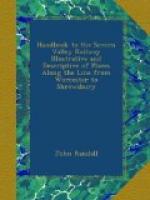[Trout: 41.jpg]
The Severn, near Wroxeter, is famous for grayling, which seldom exceed three-quarters of a pound, but which have here been caught two pounds and a half in weight. The ford has a marly or shaly bottom, and the stream is quick and clear, conditions such as this famous fish, described by Dr. Fleming as the “grey salmon,” has a liking for. It has grey longitudinal lines—hence its name—and a violet-coloured dorsal fin barred with brown; it is best in the winter and early spring months, and spawns in those of April and May. The French, who denounce the chub as “un villain,” pronounce the grayling “un chevalier.” And Gesner says, that in his country, which is Switzerland, it is accounted the choicest fish in the world. As bait, grass-hoppers or large dun flies are used, and hooks covered with green or yellow silk; in July, black and red imitation palmer worms are recommended; in August, the artificial house fly, or blue-bottle; and in winter, black or pale gnats are often used. The fords, too, from here to Buildwas are good for trout, that near Cound, from the entrance of Cound Brook into the Severn, being best.
On leaving Berrington, we come in sight of the wooded steep of Haughmond, Shakspere’s “bosky hill.” It commands the field where Falstaff fought “an hour by the Shrewsbury clock;” and has still a thicket, called the Bower, from which Queen Eleanor is said to have watched the battle in which the fortunes of her husband were involved. A castellated turret crowns the summit of the rock next the Severn; beyond, is Sundorne Castle and the ruins of Haughmond Abbey.
SHREWSBURY.
[Shrewsbury: 42.jpg]
The Severn Valley Railway affords a very interesting approach to the old Salopian capital, by bringing before the traveller its striking features, its singular situation, and its most pleasing aspect. On one side are groups of villa-looking residences, the little church of St. Giles, the column raised to Lord Hill, and the Abbey Church and buildings. On the other is the town, with its spires and towers and red-stone castle rising from an eminence above the river. The station occupies a narrow isthmus of the latter within the precincts of the castle, and is a handsome




